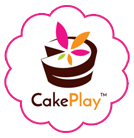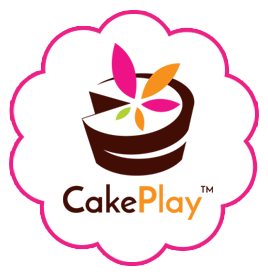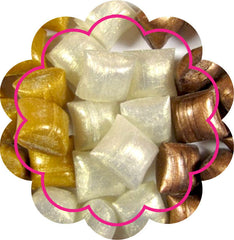Is isomalt safe to eat?
Yes, the Food and Drug Administration [FDA] has reviewed isomalt and declared it Generally Regarded as Safe, or GRAS. This designation means the substance has been approved by the FDA for its intended use as a food additive, similar to baking soda, sugar, and corn syrup. Isomalt is made from sugar beets, tastes like sugar but is sugar free. It does not cause dental cavities and is the most popular sweetener in the world behind sugar/sucrose. Isomalt has a low glycemic response, and therefore is used in many dietetic candies. The manufacturer recommends ingesting no more than 50 grams of isomalt a day within a normal diet to avoid a laxative effect. Just like many high-fiber foods, the consumption of isomalt in moderate amounts is well-tolerated by most people. Please note: CakePlay Isomalt Nibs are processed in a facility that also processes peanuts, so those with a peanut allergy should consider this before ingesting CakePlay isomalt.
Are CakePlay Isomalt Nibs kosher?
Yes, CakePlay Isomalt Nibs have been certified Pareve, or neutral, through EarthKosher. During the process of certification, every single ingredient and every single manufacturing process from origin to final product is checked, inspected, and scrutinized. This means no hidden ingredients, vague processes, or cross contamination. Kosher certification insures a very high quality product that exceeds FDA guidelines.
How long do I melt CakePlay Isomalt Nibs in the microwave?
Since microwave ovens vary in wattage, melting times may vary from customer to customer. Most decorators have success in melting a small amount of nibs in a microwave safe cup for 35 seconds on high power. After this, you can stir the isomalt and continue to melt in 15-second intervals until the isomalt is the desired consistency. Allow any bubbles to subside before pouring into your desired mold or proceeding with any other decorating technique.
Can CakePlay Isomalt Nibs be used in pulled and blown sugar projects?
Yes, professional pastry chefs and cake artists have successfully used our pure isomalt product in various pulled and blown sugar pieces without issue. Our isomalt does not contain acid, which is sometimes added to isomalt to make it softer and easier to work with. Pastry chefs and cake professionals have found it to have adequate pliability for their projects.
Can I flavor the isomalt?
Yes, very small amounts of flavoring oils may be added to isomalt as desired. However, some flavoring oils impart a color to the product or contain fine particulates that can detract from the clarity of the isomalt. We recommend testing your flavoring with a small amount of isomalt and observing the results before proceeding further.
Can CakePlay Isomalt Nibs be tinted to another color?
Yes, CakePlay has had good success with gel colors, especially since they impart less moisture to the product. Just dip a toothpick into your desired gel color and stir into the hot isomalt when the bubbles have subsided. Let the moisture sizzle off before stirring in the gel color. For a fun “swirled” look, don’t stir the gel color in completely.
Can I burn isomalt?
Yes, but only with significant overheating. This is why we recommend adding time to the microwave in small increments. When melted properly, isomalt can be heated multiple times.
When do I put finished pieces on a cake?
You can place your finished pieces directly to the cake as long as the cake doesn't need to be refrigerated. Do not refrigerate finished isomalt pieces, as the refrigerator is a humid environment. We recommend storing the pieces in a airtight container instead. If you live in a high-humidity environment, you may want to add a desiccant packet to the container with your finished piece. CakePlay offers food-safe desiccant packets in its product line.
Will CakePlay Isomalt Nibs work in a high-humidity environment?
Yes, CakePlay Isomalt Nibs are formulated to hold up to humidity. Those in extremely high-humidity environments can also protect their finished creations with an edible lacquer spray or confectionery glaze.
Will my melted isomalt have a cloudy appearance?
CakePlay Isomalt Nibs are very clear. However, the mat or mold used to cast the isomalt can give it a cloudy appearance, depending on its surface, composition, and/or density. Typically, a mold with a tighter cell structure will give better results. One technique to try for improved clarity is to rub a little vegetable oil onto the mold, then wipe it off before pouring in the melted isomalt. You can also use a crème brulee torch to restore surface clarity to the isomalt after molding. Use a light sweep with the torch to avoid losing excessive surface detail.
My molded piece looks cloudy. What should I do?
There are a number of factors which may be causing the cloudiness in your finished piece. When using a silicone mold or pouring onto a silicone mats, the piece might look cloudy. Just lightly run the flame from a crème brulee torch carefully over the mold’s surface to remove cloudiness. Excess exposure to humidity can also cause cloudiness. To remedy this, carefully run a torch over the surface to restore the piece. It is best that isomalt pieces are not stored in the refrigerator. Instead, store the isomalt pieces in an air-tight container with a food-safe desiccant packet until ready to use.
My melted isomalt has bubbles. How can I eliminate this problem?
Be sure to let melted isomalt settle for a minute or two after microwaving for bubbles to dissipate. If the bubbles are in the center of the piece, this is the most likely culprit. Watch through the window in your microwave to avoid heating the product longer than necessary, thereby forming excess bubbles. This is especially true if you are microwaving a small amount of isomalt. A good pouring spout helps eliminate some bubbles as they stretch and break when the isomalt is poured into a mold. If there are small bubbles on the surface of the isomalt in the mold after pouring, and your mold is heat-proof, the bubbles can be eliminated with use of a crème brulee torch while the isomalt is not set. Be careful not to heat the isomalt to the boiling point again with the torch – a light touch is all that is needed. The type of mold and quality of mold can affect the end results. Silicone molds give the best detail, but can cause small bubbles on the surface depending on the material and cure rate. These bubbles can be removed with a only a minor loss of detail with the careful sweep of a crème brulee torch. Another approach some people find helpful is to rub a small amount of oil into the mold before pouring in the isomalt to create a barrier between the two materials.
Can CakePlay Isomalt Nibs be used in chandelier or pearl (bead) molds?
Yes, the recommended technique is to pour the melted isomalt when it’s fairly thin and hot. Before pouring, wait a minute so any bubbles settle, then fill your desired mold. Fishing line or bead string is often used as the “string” when isomalt is poured into bead molds. Use a toothpick or the edge of a gumpaste tool to fill in the corners of the mold as needed. Remove any excess isomalt with a craft knife, or melt away excess with a crème brulee torch after removal from the mold. To eliminate fingerprints on the molded piece, stretch the mold away from the isomalt then pop your molded item onto a Silpat® mat. For hanging beads, try pouring in every other cavity.
Can CakePlay isomalt be used as edible glue?
Absolutely! Melted CakePlay Isomalt Nibs are ideal for creative tasks, including flower making, assembling the pieces of a sugar sculpture, instantly adhering decorations to fondant, and more. Melted isomalt can be used for many assembly and repair tasks, and is often quicker and easier to use for adhesion than royal icing.
I’m just getting started with isomalt. What are some easy projects I can try?
Here are some general isomalt decorating techniques:
- Try using metal cookie cutters sprayed on the inside with non‐stick spray to make lollipops.
- Making poured decorations is the best basic technique for those working with isomalt for the first time. Experiment with pouring gems, butterflies or other flat shapes using a silicone mold. Two-part press molds also add instant dimension.
- Making pulled decorations is another way to add instant dimension and glamour to pastries and cakes..
- Visit our video page for a list of free tutorials!
Can I use your isomalt in a glue gun?
CakePlay does not recommend using our product or any isomalt in a glue gun. Specialized equipment is not necessary when using our products. CakePlay’s best recommendation is simply to microwave the desired number of isomalt nibs in a silicone cup, Pyrex bowl, or other heat-proof container, then use as desired.
What are some other safety precautions I should take?
Melted isomalt is extremely hot. During any decorating project, be sure to wear heat-proof gloves and long sleeves to protect your skin. Keep a bowl of cold water nearby to immerse your hands in case of accidental contact. Do not use around children or in a high-traffic area.
What’s the best way to store my CakePlay Isomalt Nibs?
Unused CakePlay isomalt nibs can be stored in an air-tight container for up to two years. If you’ve melted some CakePlay isomalt that you won’t be using on your current project, you can pour it onto a Silpat. Then, once cool, store the isomalt in an air-tight container for a future project.
How do I preserve my isomalt creation for future use or display?
Many pastry chefs and cake decorators who work or live in humid environments use a desiccant to keep their isomalt intact. CakePlay sells food-grade desiccant packets that help preserve isomalt and gumpaste decorations. A desiccant is a drying substance that gathers moisture from the air and away from your isomalt creations. An additional strategy that is often helpful in high-humidity areas is to coat finished isomalt pieces with edible lacquer spray. Use several light, overlapping coats of edible lacquer. Do not spray any areas needed for attachment, as the edible lacquer inhibits attachment. Also, be sure both the propellant and the ingredients in the spray are food-safe.
Can decorations made with CakePlay Isomalt Nibs be used on cakes with any type of icing?
Yes, finished isomalt pieces are an ideal accent for any type of cake or pastry, including those finished with fondant, gumpaste, buttercream icing, and more. To prevent isomalt pieces from settling too far into an iced surface, particularly on buttercream cakes, you may want to mount your isomalt piece on a toothpick. To do this, adhere your piece to a toothpick with clear, melted CakePlay isomalt, allow time to harden, then place your finished piece in its desired position on the cake just before display.



